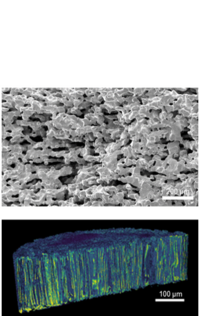Ceramic processing
Functional properties of ceramic materials "stand and fall" with processing. Investigation of ceramic synthesis, forming, and sintering methods is thus one of the core activities in our group. We study the mechanisms responsible for microstructure formation and seek ways for targeted tuning of properties by microstructural elements, such as grain size, porosity, secondary phases, dislocations, etc. In particular, we are interested in modern forming technologies (e.g., additive manufacturing) and sustainable ceramic processing methods.

Porous piezoceramics
Porous piezoceramics show many advantages over their dense counterparts and enable the preparation of active filters, catalytic support structures or polymer-ceramic composites, to be used as energy harvesters, hydrophones, or light-weight actuators. In particular, large enhancements of electromechanical properties and reduced weight can be achieved when the piezoelectric phase and the pores are oriented. We are developing new processing methods for the preparation of porous ceramic structures, including sacrificial templating or freeze casting.
SCHULTHEIß, Jan, ROSCOW, James I, KORUZA, Jurij. Orienting anisometric pores in ferroelectrics: Piezoelectric property engineering through local electric field distributions. Physical Review Materials, 2019, vol. 3, 084408.
Assoc. Prof. Dr. Jurij Koruza
Institute for Chemistry and Technology of Materials
Stremayrgasse 9
A-8010 Graz
Phone: +43 (0)316 873-32305
jurij.koruza@tugraz.at